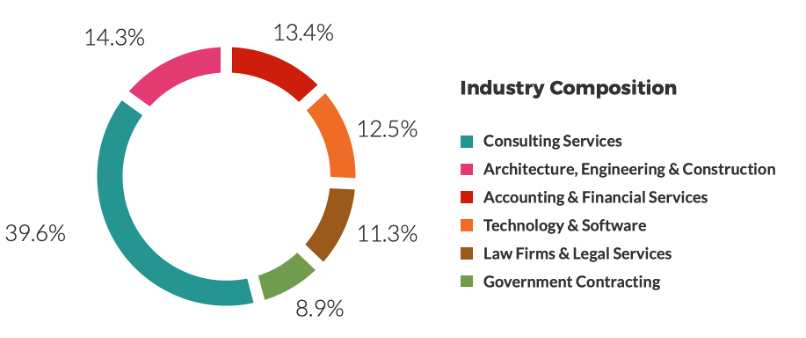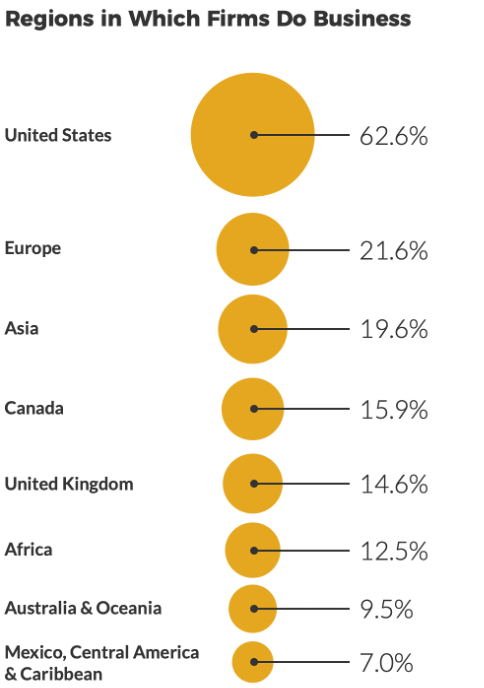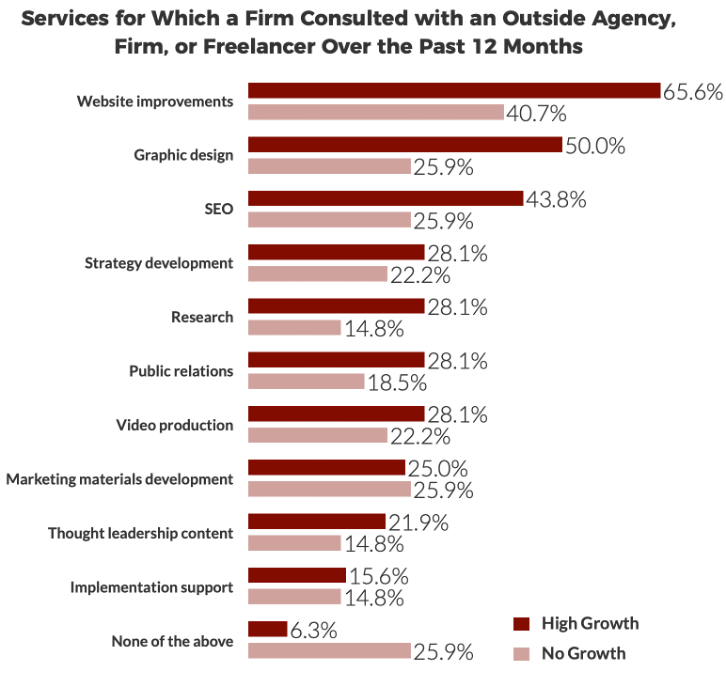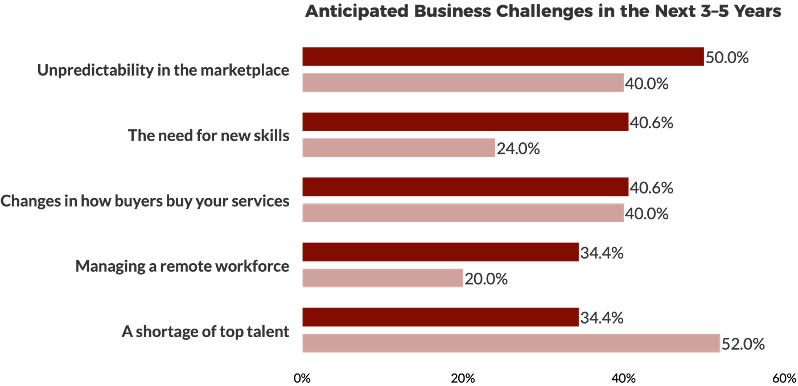If there’s one thing the financial industry can’t tolerate it’s uncertainty. While firms can develop strategies to mitigate or hedge against risk, it’s the uncertainty of being stuck in the middle that is distinctly unwelcome. From economic instability to stock market volatility, political wranglings or the war in Europe—not knowing which direction to head or what’s going to happen next leaves many in the industry watching and waiting. In such an unpredictable world, how are firms to find a foothold to move forward and succeed in such a changing environment?
Now in its eighth edition, the 2023 High Growth Study: Accounting & Financial Services Edition provides much needed insights into the best path forward. The research separates key traits of the fastest growing and most profitable firms from their “low and slow” counterparts—the ones who despite their best efforts, continue to suffer from low visibility and slow growth. In examining the characteristics of what High Growth firms are doing differently, we uncover 4 key advantages in how they use technology to drive growth, the evolving role that marketing plays in those organizations, seismic shifts in how culture is being used to attract and retain professionals, and strategies most likely to make a positive impact.
For many firms, this year is a chance to build a new foundation, putting in place the marketing systems and procedures that will drive success in 2023 and beyond.
About the Study
Every year, the Hinge Research Institute conducts a study of professional services firms to identify emerging trends and determine what the fastest growing, most profitable firms do differently. This year’s study is comprised of more than 700 participants across six industry groups with 145 respondents representing accounting & financial services. Full research reports are available for each of the industries. (Use the discount code, GROW50, and save 50% on a report purchase.)

Most of the accounting & financial services respondents were from the United States but there was representation from around the world.

Meet the High Growth Firms
What exactly is a High Growth firm? We define High Growth firms as those with a minimum of 20% compound annual growth rate over a three-year evaluation period. When we compare these firms to those that experienced little or no growth over the same time frame, we are able to identify strategies and practices that are associated with faster and more profitable growth.
This year, just under a third of the accounting & financial services firms that participated in the study were categorized as High Growth firms experiencing a median growth rate of 30%, in contrast with 10% for Average Growth firms and slightly negative growth for the No Growth firms.

High Growth firms aren’t sacrificing profitability. In fact, High Growth accounting & financial services firms earned a median profit of 26%. By contrast, their No Growth peers produced a profit of 12%. High Growth firms are more than twice as profitable.
What is driving the success of these firms in such a competitive and unpredictable marketplace? Research has identified key advantages in four key areas:
KEY ADVANTAGE 1: TECHNOLOGY
High Growth firms make greater use of marketing and business development technologies. Some of the more noticeable gaps that appeared in the research between the High Growth and No Growth firms were in the areas of CRM, communications, project management, and knowledge management. Of the more than a dozen categories in the study, High Growth firms excelled in all but one … HR management.

At its core, technology enables firms to make better data-driven decisions to accelerate growth. Shockingly, one-third of No Growth firms do not track or report on any business development or marketing metrics.
KEY ADVANTAGE 2: TALENT
Employees at High Growth firms tend to be more satisfied with their company’s culture. It’s no secret that attracting and retaining talent will continue to be a challenge. Firms need to take a fresh look at how they define and implement company culture if they hope to increase employee satisfaction, boost productivity, reduce turnover rates, and earn the distinction of a truly great place to work.
High Growth firms have also found an advantage in filling the gap with the use of outside agencies, firms, and freelancers for nearly all services.

Outsourcing gives businesses access to specific skills on an as-needed basis, while avoiding the cost and commitment of hiring full-time employees. Adopting a hybrid approach provides another very distinct advantage of having access to technologically advanced teams they normally might not—one that helps them stay at the forefront of innovation.
KEY ADVANTAGE 3: MARKETING AND BUSINESS DEVELOPMENT
High Growth firms are spending more on marketing—and the top priority by far is content creation… with brand differentiation, marketing automation and SEO following close behind in the list of top marketing priorities. Ultimately, High Growth firms are generating a greater portion of leads from digital sources than the No Growth firms. But are they doing enough when you compare that to other industries in the study? The accounting & financial services industry actually generates fewer digital leads than any other industry. In comparison, technology & software firms generate 56% more digital leads than accounting & finance firms. While the High Growth firms are doing well, there is still more opportunity in how digital techniques are being leveraged.

Another noteworthy trend is the non-traditional characteristics that make up marketing teams. No longer limited to communication and implementation tasks, the marketing function now plays a crucial role in High Growth firms’ strategy, lead generation processes, and data analysis.
KEY ADVANTAGE 4: STRATEGY
Take a look at the top 5 concerns on the list of anticipated business challenges in the next 3-5 years. While both groups are very concerned about unpredictability in the marketplace, High Growth firms were also worried about addressing the need for new skills and changes in buyer behavior. No Growth firms’ top concern was a shortage of top talent.

Firms should remain agile and be prepared to adjust from either proactive or reactive stance. With the marketplace’s continued instability, it is more important than ever to be flexible. By conducting regular research to monitor marketplace changes and validate their understanding, firms can speed up decision-making and make rapid adjustments if necessary.
We Live in an Age of Uncertainty—and an Age of Opportunity
If business concerns are keeping you up at night, you’re not alone. Uncertainty is the number one challenge facing professional services firms today. And sadly, the somber season isn’t over quite yet. From these key advantages identified in the research, one thing is clear: Navigating through these challenges requires the ability to measure and quantify your technology, your culture, and your marketing efforts from multiple perspectives to identify where the greatest opportunities exist.
Embrace new thinking and champion new priorities. You can start by purchasing the High Growth Study 2023: Accounting & Financial Services Edition report that this article is based upon. Learn more about the technology, talent, marketing and business development, and strategy advantages that the High Growth firms have. Get findings, insights, and tips that you can apply immediately. The High Growth firms in this research found ways to work around uncertainty—and grow. You can too. (Remember to use the discount code, GROW50, to save 50% on your research report purchase.)

